Flow Characteristics and Switching Mechanism of Bistable Slit Flow Actuated by Temperature
Abstract
1. Introduction
2. Model and Method
2.1. Physical Model and Mechanism
2.2. Governing Equations
2.3. Meshing and Validation
3. Results and Discussion
3.1. Flow Characteristics in Slit Imposed by Heat
3.2. Effect of Temperature Gradient on Bistable Slit Flow
3.3. Switching Characteristics of Temperature-Driven Bistable Flow
3.4. Mechanism of Flow Deflection Driven by Temperature Gradient
3.5. Switching Mechanism of Flow Attachment Locked by Temperature
3.6. Deflection Characteristics of Temperature-Driven with Disturbed Flow
4. Conclusions
- (1)
- Temperature gradient can be a trigger to realize the control of bistable slit flow. The slit flow observably deflects and then is locked to the heated side under the impact of the temperature gradient. With the increase in the temperature gradient, the flow deflection angle becomes larger, which induces a jump in the flow mass ratio between the outlets. The ratio of slit length to slit width makes a difference in the flow deflection under the same temperature gradient, but the significance of the flow deflection is weaker after the ratio attains 10, which suggests there is an optimized structure parameter.
- (2)
- The slit flow can be switched from one side to the other, driven by temperature. When the opening angle between the outlets is 24°, Reynolds number 167, and the slit temperature gradient is 40 K, the whole switching time costs 4.54 s and can be reduced by enlarging the temperature gradient.
- (3)
- The mechanism of flow deflection and switching is investigated based on an analysis of the pressure distribution, the velocity gradient, and the vorticity development. It demonstrates that the heat input causes a pressure drop as well as an enhancement of the velocity gradient. The position where the shear stress is zero moves closer to the high-temperature wall with the amplified temperature difference. The development of vorticity in the switching process reveals that the variation of viscosity significantly determines the switching time.
- (4)
- The ability of temperature to control the flow with disturbance is somewhat weakened, but for the fluid with a frequency of 0.5 Hz and a Reynolds number range of 119–198, temperature still has the ability to control.
Author Contributions
Funding
Institutional Review Board Statement
Data Availability Statement
Conflicts of Interest
References
- Greenblatt, D.; Whalen, E.A.; Wygnanski, I.J. Introduction to the Flow Control Virtual Collection. AIAA J. 2019, 57, 3111–3114. [Google Scholar] [CrossRef]
- Raman, G.; Raghu, S. Cavity Resonance Suppression Using Miniature Fluidic Oscillators. AIAA J. 2004, 42, 2608–2612. [Google Scholar] [CrossRef]
- Schmidt, H.J.; Woszidlo, R.; Nayeri, C.N.; Paschereit, C.O. Separation control with fluidic oscillators in water. Exp. Fluids 2017, 58, 106–123. [Google Scholar] [CrossRef]
- Dolgopyat, D.; Seifert, A. Active Flow Control Virtual Maneuvering System Applied to Conventional Airfoil. AIAA J. 2019, 57, 72–89. [Google Scholar] [CrossRef]
- Bohan, B.T.; Polanka, M.D.; Rutledge, J.L. Sweeping Jets Issuing From the Face of a Backward-Facing Step. J. Fluids Eng. 2019, 141, 121201. [Google Scholar] [CrossRef]
- Zhang, X.; Peng, J.; Liu, H.; Wu, D. Performance Analysis of a Fluidic Axial Oscillation Tool for Friction Reduction with the Absence of a Throttling Plate. Appl. Sci. 2017, 7, 360. [Google Scholar] [CrossRef]
- Zhang, X.; Peng, J.; Ge, D.; Bo, K.; Yin, K.; Wu, D. Performance Study of a Fluidic Hammer Controlled by an Output-Fed Bistable Fluidic Oscillator. Appl. Sci. 2016, 6, 305. [Google Scholar] [CrossRef]
- Wassermann, F.; Hecker, D.; Jung, B.; Markl, M.; Seifert, A.; Grundmann, S. Phase-locked 3D3C-MRV measurements in a bi-stable fluidic oscillator. Exp. Fluids 2013, 54, 1487. [Google Scholar] [CrossRef]
- Zheng, J.G.; Xia, L.; Hu, J.; Mao, Y.J. Numerical investigation of characteristics of fluidic oscillator operating in quiescent air and a crossflow. Aerosp. Sci. Technol. 2021, 113, 106731. [Google Scholar] [CrossRef]
- Wang, S.; Batikh, A.; Baldas, L.; Kourta, A.; Mazellier, N.; Colin, S.; Orieux, S. On the modelling of the switching mechanisms of a Coanda fluidic oscillator. Sens. Actuators A Phys. 2019, 299, 111618. [Google Scholar] [CrossRef]
- Wen, X.; Li, Z.; Zhou, L.; Yu, C.; Muhammad, Z.; Liu, Y.; Wang, S.; Liu, Y. Flow dynamics of a fluidic oscillator with internal geometry variations. Phys. Fluids 2020, 32, 075111. [Google Scholar] [CrossRef]
- Tesař, V.; Šonský, J. No-moving-part electro/fluidic transducer based on plasma discharge effect. Sens. Actuators A Phys. 2015, 232, 20–29. [Google Scholar] [CrossRef]
- Mair, M.; Bacic, M.; Ireland, P. On Dynamics of Acoustically Driven Bistable Fluidic Valves. J. Fluids Eng. 2019, 141, 061202. [Google Scholar] [CrossRef]
- Chen, L.-W.; Turner, J.; Bacic, M.; Ireland, P. Exeprimental and Numerical Studies of a Plasma Fluidic Device for Active Flow Control. In Proceedings of the 8th AIAA Flow Control Conference, Washington, DC, USA, 13–17 June 2016. [Google Scholar]
- Gregory, J.W.; Gnanamanickam, E.P.; Sullivan, J.P.; Raghu, S. Variable-Frequency Fluidic Oscillator Driven by a Piezoelectric Bender. AIAA J. 2009, 47, 2717–2725. [Google Scholar] [CrossRef]
- Kumar, S.; Laughlin, G.; Cantu, C. Near-wake structure behind two circular cylinders in a side-by-side configuration with heat release. Phys. Rev. E Stat. Nonlinear Soft Matter Phys. 2009, 80, 066307. [Google Scholar] [CrossRef]
- Al-Rawashdeh, M.m.; Yue, F.; Patil, N.G. Designing Flow and Temperature Uniformities in Parallel MicroChannel Reactor. AIChE J. 2014, 60, 1941–1952. [Google Scholar] [CrossRef]
- Pavlovich Moshkin, N.; Sompong, J. Numerical simulation of heat transfer and fluid flow over two rotating circular cylinders at low Reynolds number. Heat Transf.-Asian Res. 2010, 39, 246–261. [Google Scholar] [CrossRef]
- Jogee, S.; Anupindi, K. Near-wake flow and thermal characteristics of three side-by-side circular cylinders for large temperature differences using large-eddy simulation. Int. J. Heat Mass Transf. 2022, 184, 122324. [Google Scholar] [CrossRef]
- Lee, C.-S.; Shih, T.I.P. Effects of heat loads on flow and heat transfer in the entrance region of a cooling duct with a staggered array of pin fins. Int. J. Heat Mass Transf. 2021, 175, 121302. [Google Scholar] [CrossRef]
- Ritos, K.; Lihnaropoulos, Y.; Naris, S.; Valougeorgis, D. Pressure- and Temperature-Driven Flow Through Triangular and Trapezoidal Microchannels. Heat Transf. Eng. 2011, 32, 1101–1107. [Google Scholar] [CrossRef]
- Ohta, T.; Kajishima, T.; Mizobata, K.; Nakamura, K. Influence of density fluctuation on DNS of turbulent channel flow in the presence of temperature stratification. Flow Turbul. Combust. 2012, 89, 435–448. [Google Scholar] [CrossRef]
- Alexeenko, A.A.; Gimelshein, S.F.; Muntz, E.P.; Ketsdever, A.D. Kinetic modeling of temperature driven flows in short microchannels. Int. J. Therm. Sci. 2006, 45, 1045–1051. [Google Scholar] [CrossRef]
- Khalde, C.M.; Pandit, A.V.; Sangwai, J.S.; Ranade, V.V. Flow, mixing, and heat transfer in fluidic oscillators. Can. J. Chem. Eng. 2019, 97, 542–559. [Google Scholar] [CrossRef]
- Peng, J.-M.; Zhang, Q.; Li, G.-l.; Chen, J.-W.; Gan, X.; He, J.-f. Effect of geometric parameters of the bistable fluidic amplifier in the liquid-jet hammer on its threshold flow velocity. Comput. Fluids 2013, 82, 38–49. [Google Scholar] [CrossRef]
- ZHANG, J. Advanced Heat Transfer; China Science Publishing: Beijing, China, 2009; p. 383. [Google Scholar]
- Dumas, A.; Subhash, M.; Trancossi, M.; Marques, J.P. The Influence of Surface Temperature on Coanda Effect. Energy Procedia 2014, 45, 626–634. [Google Scholar] [CrossRef]
- Su, L.; Duan, Z.; He, B.; Ma, H.; Ning, X.; Ding, G.; Cao, Y. Heat transfer characteristics of thermally developing flow in rectangular microchannels with constant wall temperature. Int. J. Therm. Sci. 2020, 155, 106412. [Google Scholar] [CrossRef]
- Shah, R.K.; London, A.L. Laminar Flow Forced Convection in Ducts; Academic Press: New York, NY, USA, 1978; p. 477. [Google Scholar]
- Olinto, C.R. Experimental Study of the Bistable Flow in Tube Arrays. J. Braz. Soc. Mech. Sci. Eng. 2006, 28, 233–241. [Google Scholar] [CrossRef]
- Schlichting, H. Boundary-Layer Theory, 9th ed.; Springer: Berlin/Heidelberg, Germany, 2017. [Google Scholar]
- Luo, G.; Shi, L.; Song, H.; Li, M.; Zhong, Y.; He, X.; Fu, H. Microfluidic switches driven by mechanically guided multistable buckling. Extrem. Mech. Lett. 2022, 54, 101763. [Google Scholar] [CrossRef]
- Wang, H.; Yin, F.; Li, Z.; Su, W.; Li, D. Advances of microfluidic lung chips for assessing atmospheric pollutants exposure. Environ. Int. 2023, 172, 107801. [Google Scholar] [CrossRef]
- Augustine, R.; Aqel, A.H.; Kalva, S.N.; Joshy, K.S.; Nayeem, A.; Hasan, A. Bioengineered microfluidic blood-brain barrier models in oncology research. Transl. Oncol. 2021, 14, 101087. [Google Scholar] [CrossRef]

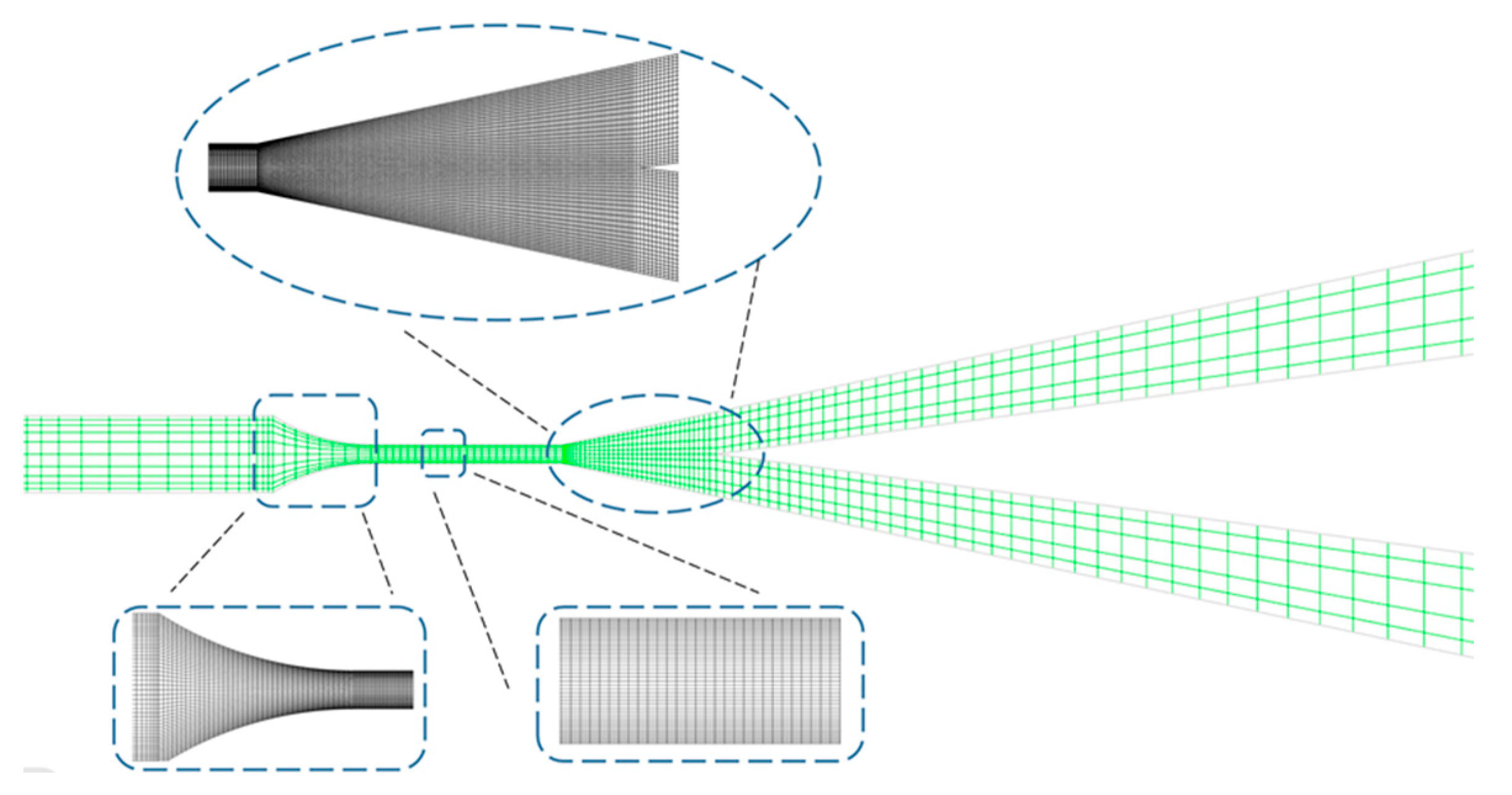

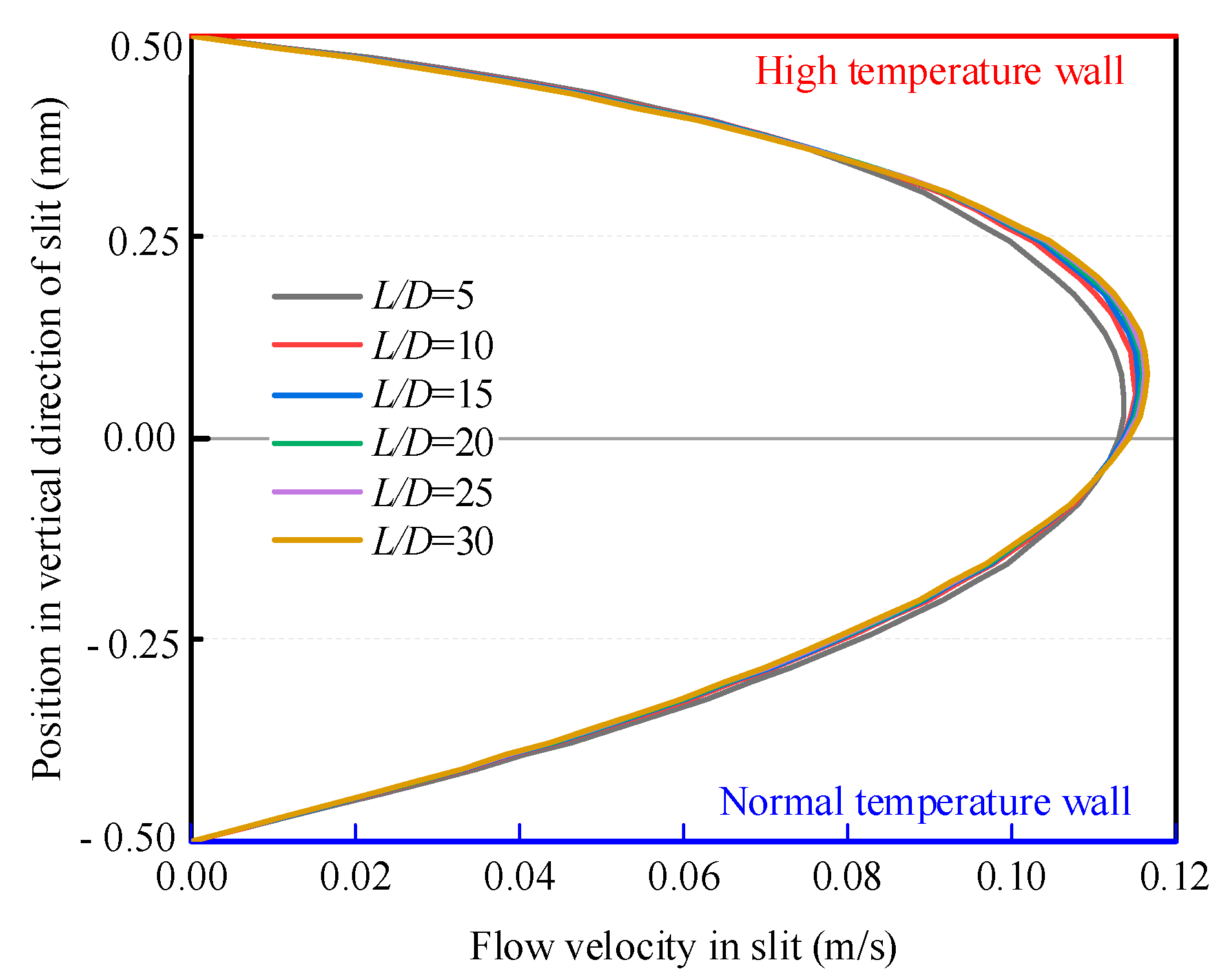
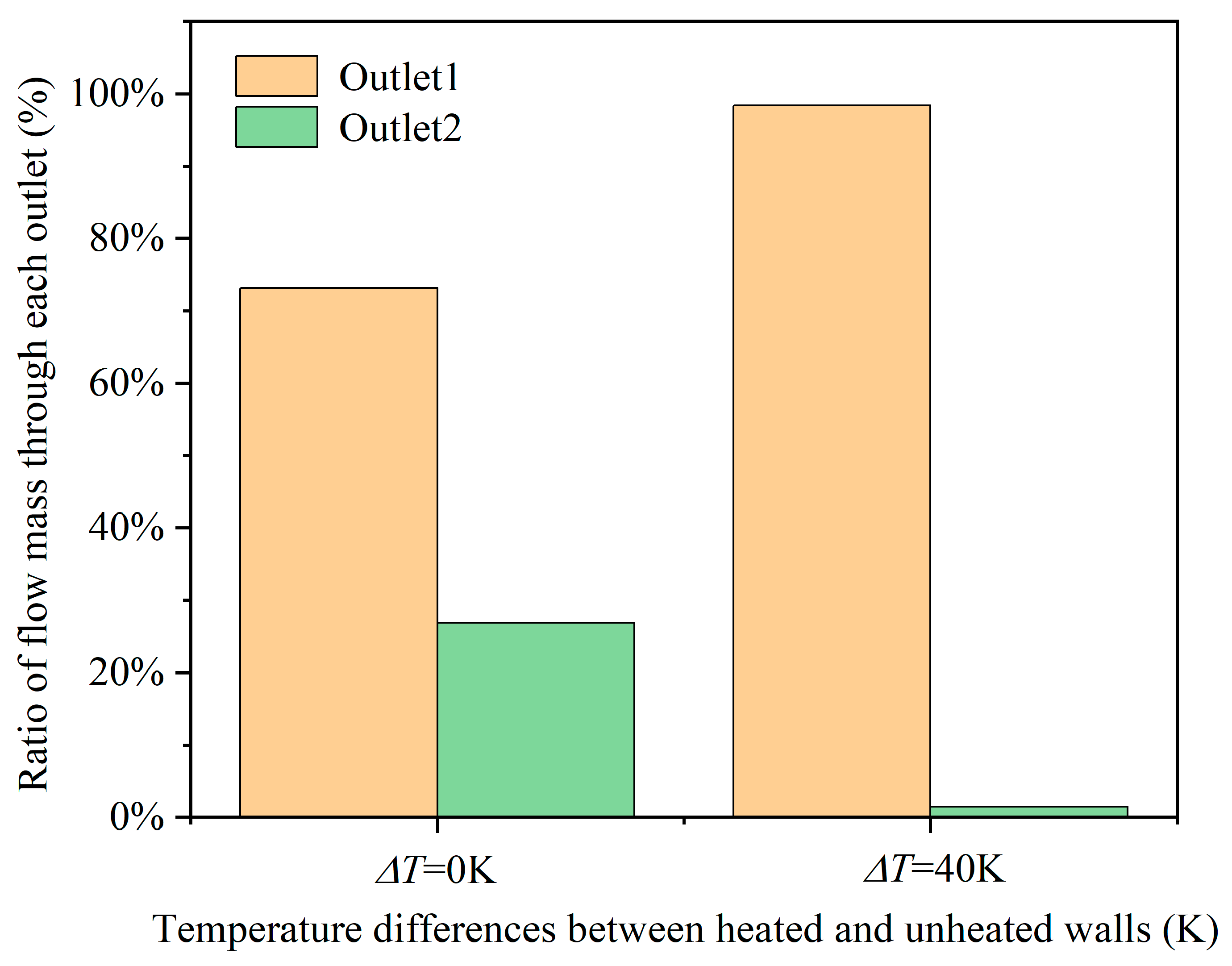
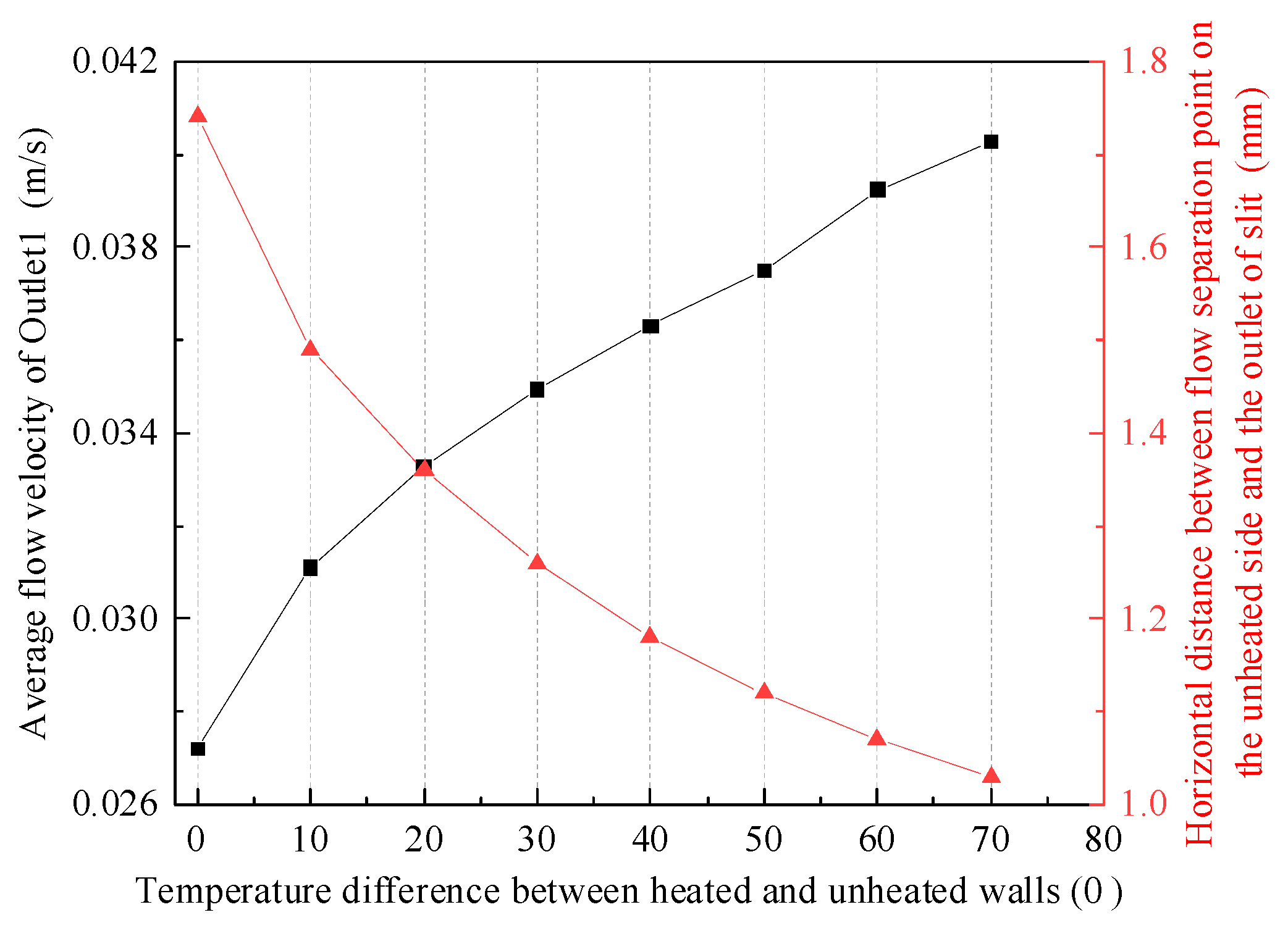
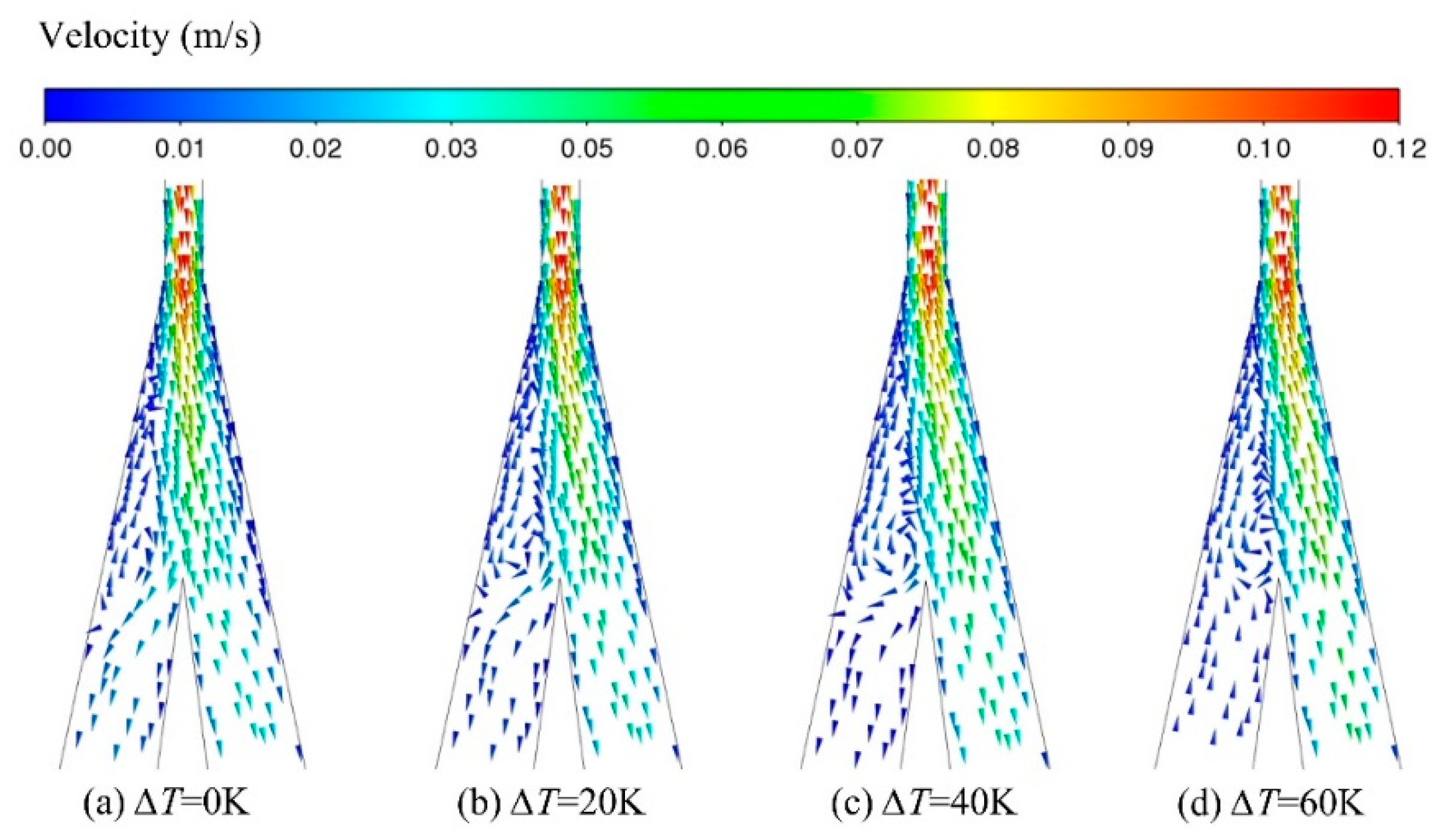

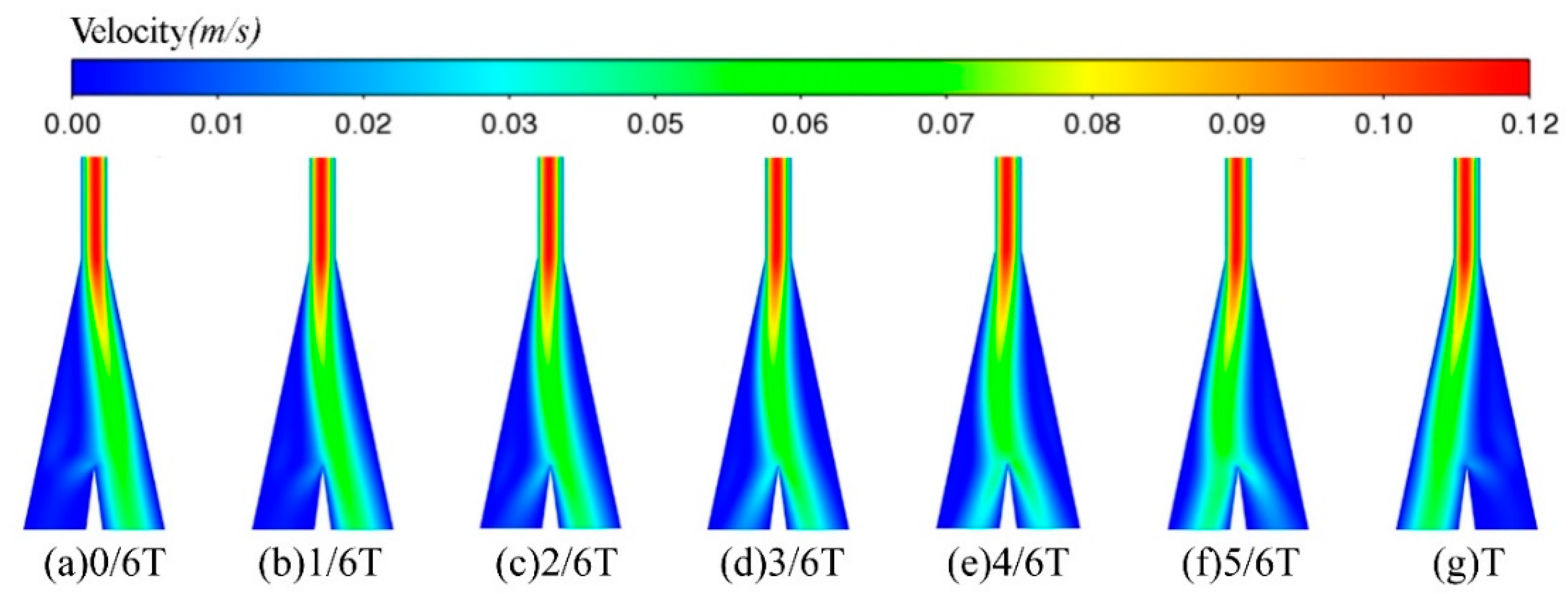
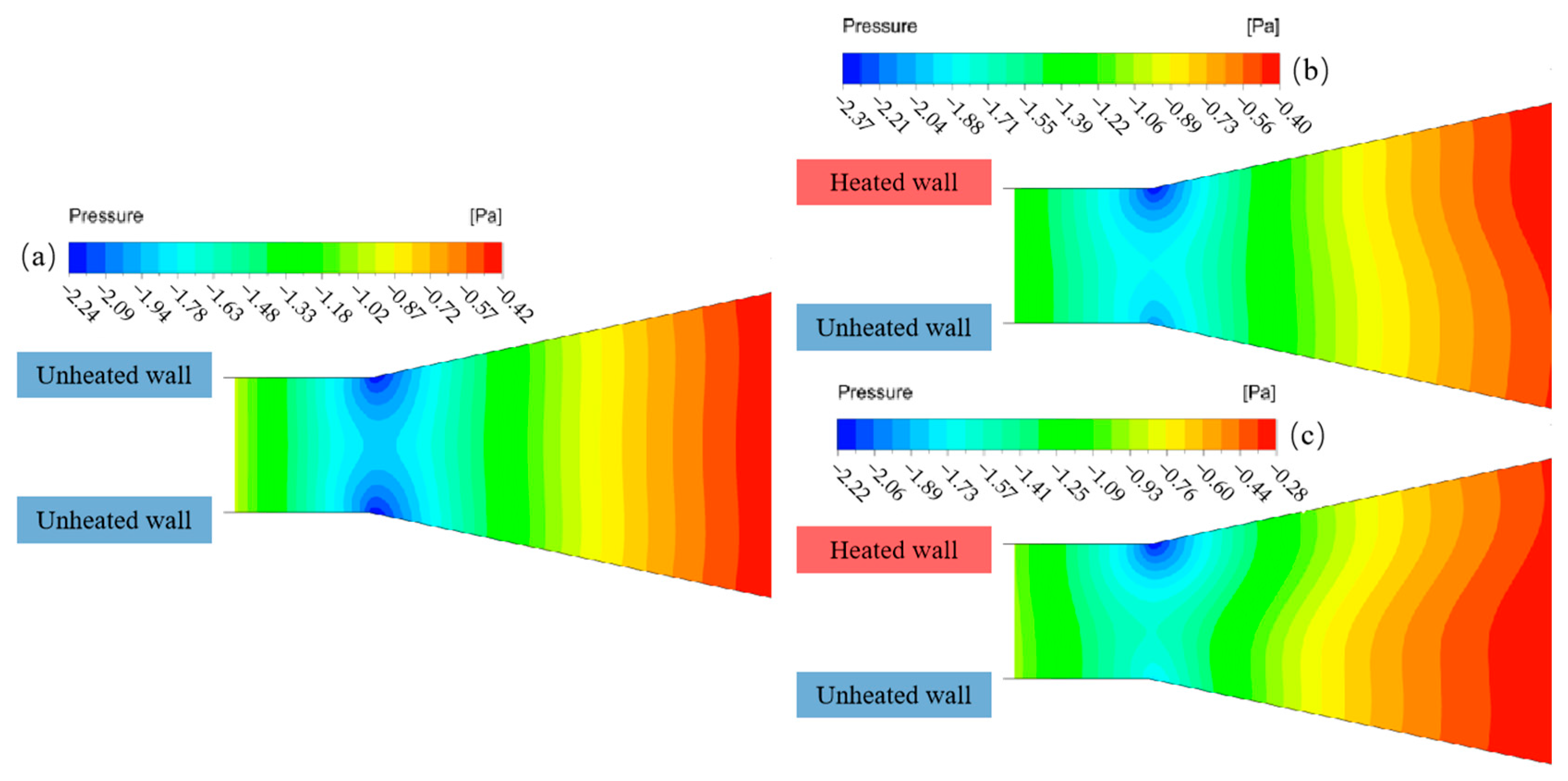
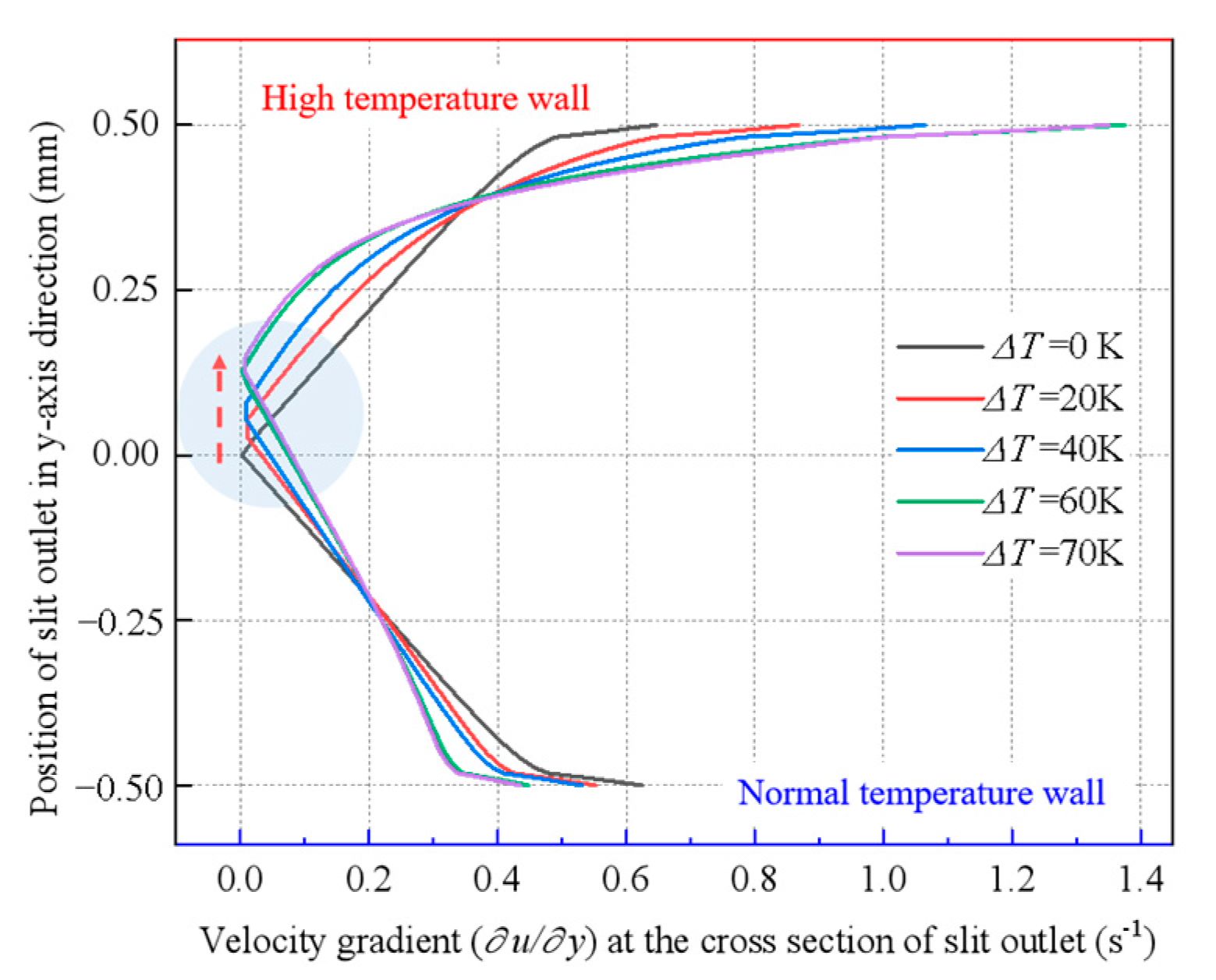
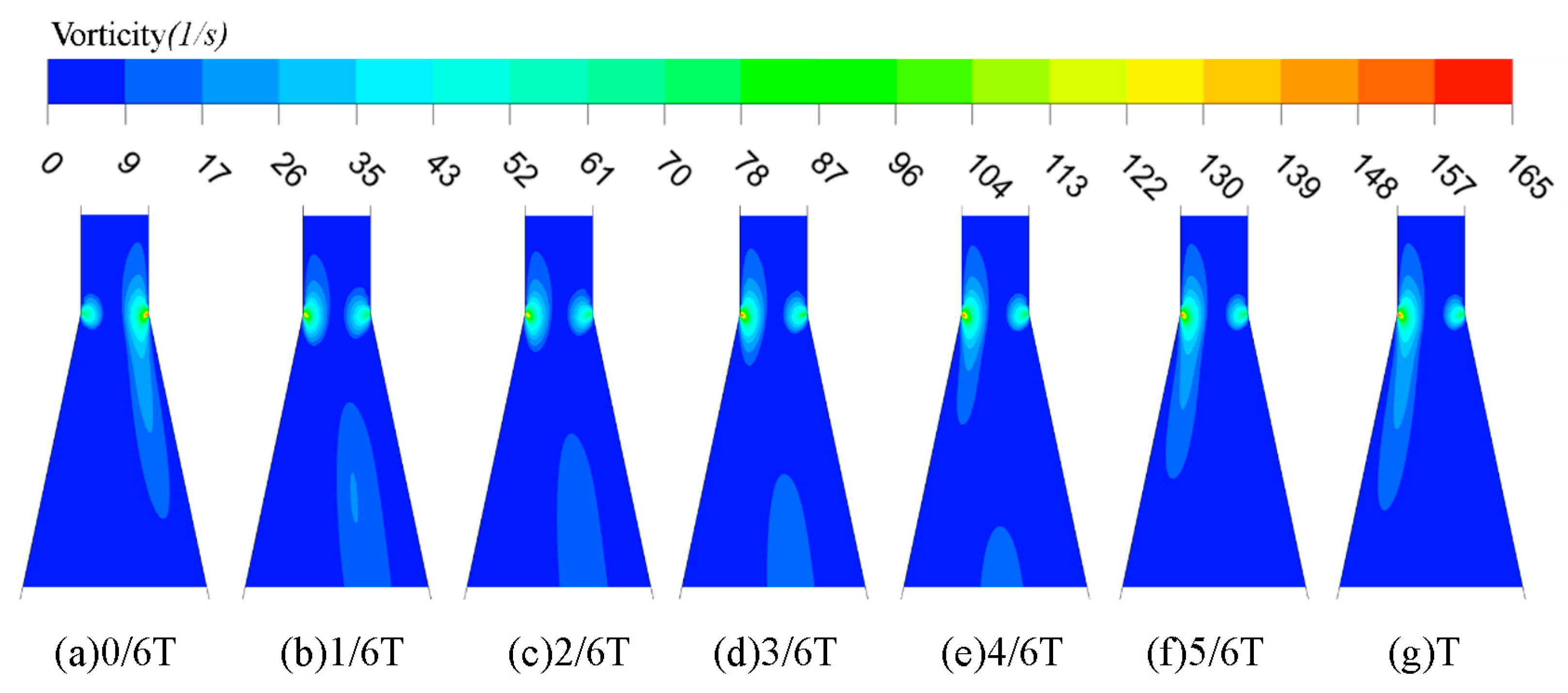
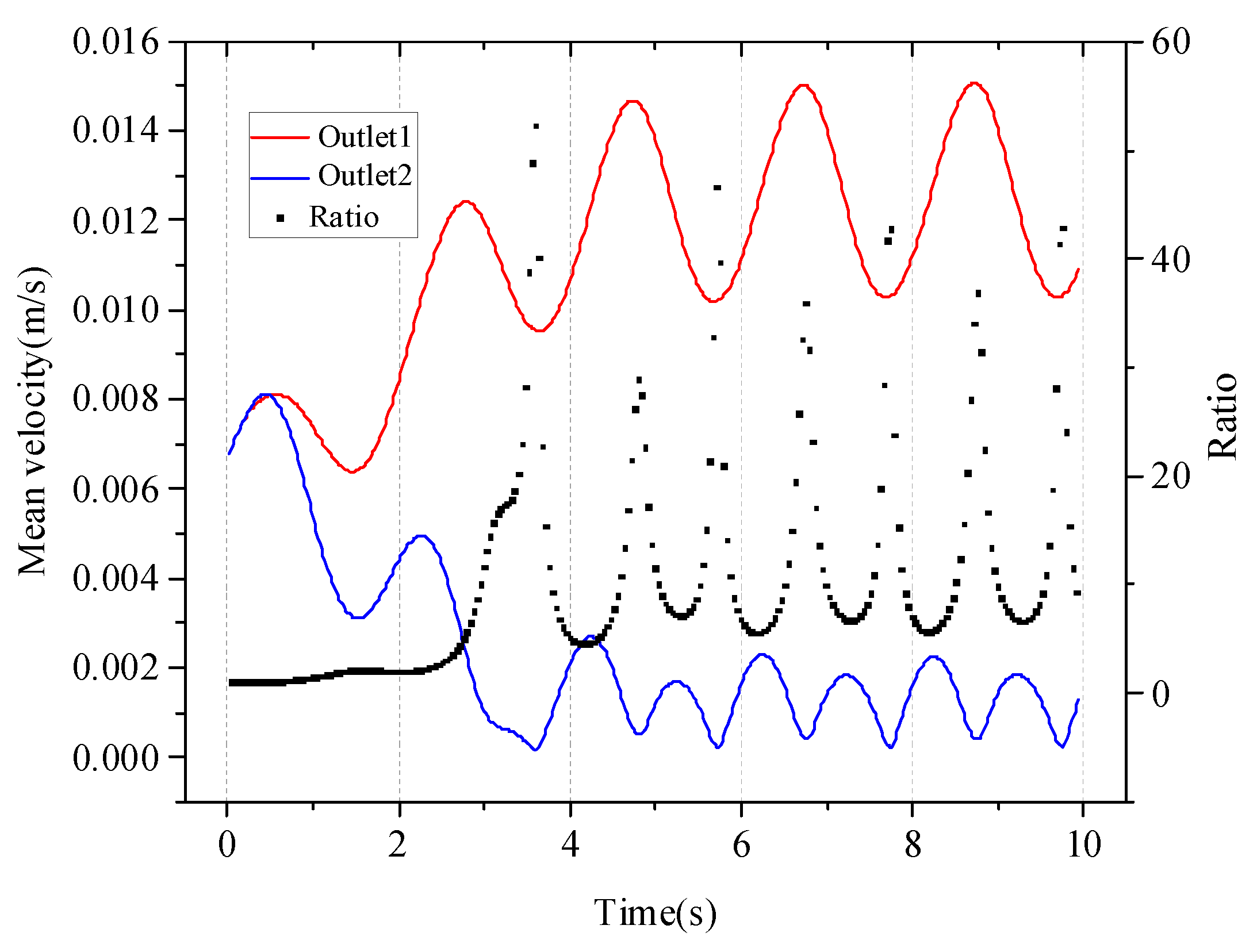
| Grid Numbers | Outlet 1 Velocity (×10−2) (m/s) | Outlet 2 Velocity (×10−4) (m/s) | |
|---|---|---|---|
| Coarse grids | 9150 | 1.4542 | 2.3166 |
| Medium grids | 27,050 | 1.4507 | 2.4241 |
| Fine grids | 47,600 | 1.4508 | 2.4634 |
| Deviation (%) | 0.23% | 5.96% |
Disclaimer/Publisher’s Note: The statements, opinions and data contained in all publications are solely those of the individual author(s) and contributor(s) and not of MDPI and/or the editor(s). MDPI and/or the editor(s) disclaim responsibility for any injury to people or property resulting from any ideas, methods, instructions or products referred to in the content. |
© 2023 by the authors. Licensee MDPI, Basel, Switzerland. This article is an open access article distributed under the terms and conditions of the Creative Commons Attribution (CC BY) license (https://creativecommons.org/licenses/by/4.0/).
Share and Cite
Nie, H.; Lv, Y.; Du, T.; Song, X. Flow Characteristics and Switching Mechanism of Bistable Slit Flow Actuated by Temperature. Entropy 2023, 25, 650. https://doi.org/10.3390/e25040650
Nie H, Lv Y, Du T, Song X. Flow Characteristics and Switching Mechanism of Bistable Slit Flow Actuated by Temperature. Entropy. 2023; 25(4):650. https://doi.org/10.3390/e25040650
Chicago/Turabian StyleNie, Huacheng, Yuexia Lv, Tingting Du, and Xinyu Song. 2023. "Flow Characteristics and Switching Mechanism of Bistable Slit Flow Actuated by Temperature" Entropy 25, no. 4: 650. https://doi.org/10.3390/e25040650
APA StyleNie, H., Lv, Y., Du, T., & Song, X. (2023). Flow Characteristics and Switching Mechanism of Bistable Slit Flow Actuated by Temperature. Entropy, 25(4), 650. https://doi.org/10.3390/e25040650






